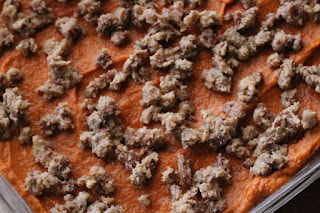Fermentation is a very old form of preservation, and the process gives us many things we wouldn't have otherwise (at least maybe not in such an easily recognizable manner). Tea, coffee, chocolate, olives, beer and wine, pickles, yogurt, breads...
Thrilling as it may be, I realize there's probably no one out there with a burning desire for sauerkraut. Well, I suppose I can't say that for certain- maybe there is, I don't know.
Anyway, while you personally may not have a strong desire for it, sauerkraut can definitely make a nice accompaniment to certain dishes.Fermentation occurs because in a situation where there is an absence of oxygen, the micro-organisms that naturally live on plants reproduce rapidly and are able to suppress development of the "bad" microbes that would cause spoilage. The "good" ones are the first to digest the sugars in the cabbage and then give off substances like carbon dioxide and lactic acid that keep the baddies from forming.
However, you've got to remember that fermentation can potentially be a bit dangerous. When things start to ferment, they produce gas and build up pressure. No one wants a sauerkraut explosion, so just keep an eye on things. You'll need to periodically open the jar and let off the carbon dioxide, maybe use a knife along the sides of the jar to release bubbles, the compress the ribbons of cabbage so that everything stays under a layer of liquid.
When the sauerkraut has finished fermenting, just place it in the refrigerator. It will continue to ferment, but the cooler temperature in the refrigerator drastically slows the process.
Sauerkraut
2 lb. (900 g) cabbage (red or green)
4 t (20 g) sea salt
Remove the outer leaves from the cabbage. Cut the cabbage in quarters from top to bottom and remove most of the solid core. Slice one of the quarters into ribbons somewhere between 1/2 cm and 1 inch depending on our preference (more thinly sliced cabbage will ferment more quickly and be softer in texture, while the thicker cut will be crunchier). Repeat with the other three quarters, and attempt to cut the cabbage all about the same thickness.
Place all the cut cabbage in a large bowl. Sprinkle the cabbage with the salt and with clean hands fold, toss, and finally massage the salt into the cabbage. In the beginning this may be a bit difficult, but it should become easier after a while as you see some progress. Eventually, the cabbage will soften and begin to give off liquid (this can take up to 15 minutes).
Once you are able to squeeze liquid out of a handful of cabbage, firmly pack it into one or more jars.
Use a spatula, glass, or another smaller jar to push down the mixture and get rid of any air in the jar. The liquid should rise above the cabbage and completely cover it. Make sure that there is at least an inch (2.5 cm) of space between the cabbage mixture and the top of the jar to accommodate for expansion during fermentation.
Close the jar and place in a cool dark place.
Check the sauerkraut daily. Open the jar, re-pack the sauerkraut to cover with the liquid and release the bubbles. After a few days the mixture will become very bubbly (and build up a lot of pressure in the jar). Smell and taste the mixture, which should start to sour.
Let the cabbage ferment at least 5 days and up to a month, depending on your taste.
Place the sauerkraut in the refrigerator in an airtight container, where it should keep several months.










































